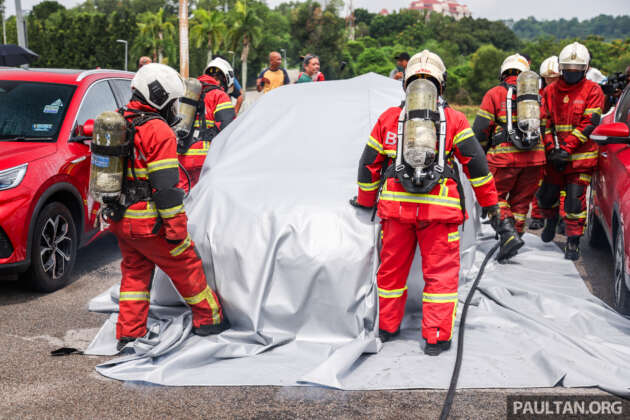Four electric vehicle (EV) fires occurred in Malaysia between January and September this year, reports The Sun. This is according to Putrajaya fire and rescue department fire safety division director Datuk Khirudin Drahman Hussain, who advised EV owners to follow the manufacturer’s manual to ensure safe operation and reduce the risk of fires.
“EV owners should avoid overcharging, monitor charging sessions and ensure that their vehicles are not exposed to extreme heat or debris. It can take from five to 24 hours to fully extinguish an EV fire, depending on the size of the battery (kWh) and the fire load involved. Due to thermal runaway, the high heat and rapid deflagration process make EV fires difficult to extinguish with regular ABC dry powder or water unless the vehicle is flooded with ice,” he said.
Out of the four EV fires this year, one occurred during charging, while three were due to accidents. When thermal runaway occurs, the battery pack overheats and ignites other cells, leading to an intense and prolonged fire that can release large amounts of heat, toxic gases and chemical fumes.
At present, water and a special fire blanket are used to deal with EV fires, although they only serve to prevent the fire from spreading and not to extinguish it. It can take a very long time to put out an EV battery fire experiencing thermal runaway, as evident by this case involving a Tesla Semi back in August.
Under the new fire safety guidelines, EV charging bays in Malaysia must have an EV fire blanket at a strategic point or a fire command centre. Firefighters are also undergoing training and exposure to EV fires to learn how to deal with them as well as the extra precautions required, including wearing full personal protective equipment with a set of breathing apparatus.
Khirudin also noted that fires involving EV batteries can lead to a vapour cloud explosion, with a 70% likelihood in basements or enclosed areas, ultimately producing highly toxic gases. “Despite frequent warnings about fire dangers, many people believe it is a remote risk that only affects others. It’s important to be extra cautious and alert to prevent potential incidents,” he said.
Meanwhile, Universiti Teknologi Malaysia (UTM) automotive development centre director Dr Mohd Azman Abas said EV battery technologies are important in minimising the risk of a fire. “While most electric vehicles currently use lithium-ion batteries, which offer high energy density and efficiency, they are also more susceptible to risks such as overheating, which can result in thermal runaway,” he explained.
The way a battery is designed and managed is important, with systems needing to ensure safe charging and discharging as well as avoid overheating, overcharging or short circuits. He added that researchers are exploring the integration of artificial intelligence (AI) to enhance the system’s ability to predict and detect potential issues.
Looking to sell your car? Sell it with Carro.



“EV owners should avoid overcharging, monitor charging sessions and ensure that their vehicles are not exposed to extreme heat or debris”
On top of that, got to monitor your range, locating charger like Pokemon Go and having sleepless nights.
Buy so expensive and yet need to worry so many things. Why make life difficult?
You won’t change your mind but I will share my own experience.
I own two EVs, first one for nearly 3 years already and have no such worries.
Two year service cycle, no oil change, no visits to petrol station in 30 months. Fast, quiet and comfortable.
You have a smartphone? All those “worries” apply to smartphone that you cant live without.
How much a smartphone cost vs an EV? You replace smartphone after couple of years when the batt deteriorate. And smartphone fire don’t last for hours. And you don’t expose your smartphone to heat and sun like EV.
When smartphone our of juice, there’s powerbank. Do you have portable powerbank for EV?
Kang dah kena. Act pandai konon.
EV battery bms won’t allows overcharging. Charging once reached 80% automatically goes into trickle charging mode.
whats the reason the EV burn on highway near toll last week? Seems only 1 car around. not like a crash
This cannot be true. I saw an EV fire earlier this year, and it has not been recorded here.
If you are referring to the BMW i8 on Kesas last week, it is a Hybrid, not EV.. No clue whether is it due to battery or petrol.
It’s a Russian roulette.
I assuming one of them was a Mercedes EQ charging at the dealer.
It will be interesting if we are able to identify were those 4 EVs using NMC type battery? Typically most European/American/Korean EV uses NMC while most China EV prefer LFP (Although some low spec like Model 3 base model use LFP). On paper LFP should have better thermal runaway resistance than MNC.
so few EVs on the road yet already 4 fires in 9 months this year.
How many ICE fires occurred in Malaysia this year ? Gotta know both, can’t be bias.
I can see where you are coming from by comparing the probability of catching fire between ICE and EV. However the point here is that EV fire is way much more harder to be extinguished compared to ICE. 100,000L of water for EV vs 1000L of water for ICE in one study. In some cases, fire extinguisher might be sufficient to minimize the damage for ICE but no chance for EV.
The EV fire incident in South Korea underground carpark got everyone stood up, more than 100 vehicle got burn down, 23 people hospitalized and evacuated more than 100 people from the home.
The probability could be rare, but once it happen it can be catastrophic, that is why it caught people’s attention and people has the right to know what safety measures that has taken by our authority and what are the consumers’ responsibility to keep everyone safe.
Point taken. But don’t worry, have faith in our Abang Bomba, as demonstrated they know how to use EV fire blanket.
EV battery is not hard to extinguish. It’s impossible to extinguish with bomba facilities. EV battery repair centre have submersion pool standby. In case it catches fire, the batteries will be submerged to the pool. Even that also won’t guarantee that it will put off the fire.
“Out of the four EV fires this year, one occurred during charging, while three were due to accidents.”
How many EVs are registered on our Malaysia road?
What percentage are we dealing with now?
Go Google “EV vs ICE fire statistics per million miles”
ICE are between 10x to 60x more likely to catch fire than EVs depending on the study
Full EV. risk of fire is high. burn car maybe can say nvm, but then charge at home, burn home as well, how? accident time, also scare caught fire.. or.. ppl bang your car, wiring compromised, sensors kaput, wonder even repair will be 100% or not.. it’s like having BOMB at home. or driving a luck based time bomb.
Wuhanians loves EV betul tak ?